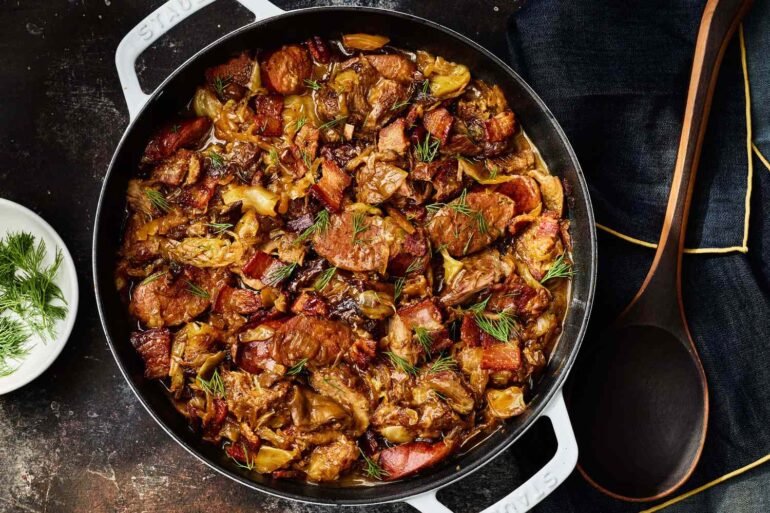:max_bytes(150000):strip_icc():format(jpeg)/Bigos-FT-RECIPE1025-c3fcd8b26c77441cb90aa68ec73ad9fc.jpg)
• Meaty pork shoulder and spicy kielbasa are balanced by tangy sauerkraut and fresh cabbage, all with a finishing pop of prune sweetness.
• Bacon drippings, well-browned pork, beer, juniper, and porcini are smartly layered to build complexity without fuss.
• This stew tastes even better after an overnight rest. Start a day ahead and simply reheat when ready to eat.
Bigos, also known as Polish hunter’s stew, is a dish built for winter and for sharing. At its heart is the marriage of fresh cabbage and lively sauerkraut, a duo that creates body and brightness in the same pot. This recipe leans into that satisfying contrast with smoky bacon that lays the groundwork, pork shoulder that is browned for fond and flavor, and kielbasa to bring a savory snap. Dried porcini add woodland depth, a lager lends gentle bitterness and lift, and juniper berries and bay leaves thread in resinous, aromatic notes usually found in game cookery. Prunes are stirred in near the end so they soften without disappearing, adding a quiet sweetness that rounds the edges of acidity and salt.
Bigos is remarkably forgiving and famously better on day two. As it simmers, the cabbage turns silky and the flavors integrate; as it rests, everything settles into a cohesive, craveable stew. Every family has their own way — some add tomatoes or apples, others include venison. In this version, we keep the focus on pork, mushrooms, and brassica tang, but feel free to experiment with your favorite blend of meat and sausage.
Bigos is hearty but not heavy, brothy yet plush, and packed with texture, from the tender pork to the slight crunches of sauerkraut. Serve it with rye bread or boiled potatoes to catch the broth, and pass a little dill for fresh contrast. Whether you’re cooking for a crowd or planning cozy leftovers, bigos offers maximal payoff for a leisurely afternoon at the stove.
The importance of kielbasa
Kielbasa is a broad Polish term for sausage. In the U.S. it usually means a smoked pork or pork-and-beef link seasoned with garlic, marjoram, black pepper, and sometimes mustard seed. It’s firm, juicy, gently smoky, and savory with a garlicky snap. Good substitutes include smoked bratwurst, andouille (milder varieties), German knackwurst, smoked turkey sausage, or Portuguese linguiça.
What’s the best lager for making bigos?
A Vienna-style lager, such as the Samuel Adams Boston Lager, is ideal as the toasty caramel notes echo smoked kielbasa, pork, and dried plums without sweetness. Skip IPAs and other aggressively hopped beers like pilsners, as their hoppy bitterness fights the tangy sauerkraut.
Notes from the Food & Wine Test Kitchen
- Refrigerated, fresh sauerkraut (we like one with caraway) brings better texture and tang than shelf-stable versions. Drain before adding to avoid contributing too much acidity.
- Brown the pork deeply but avoid crowding; a good sear is key to a flavorful broth
- Bigos blooms with time so cook ahead if you can, chill, and reheat gently. The flavors knit beautifully by day two.
Suggested pairing
Dr. Loosen “Blue Slate” Riesling Kabinett. Brisk acidity slices through rich pork and kielbasa, while a touch of residual sweetness softens sauerkraut’s tang and marries with prunes. Slatey minerality keeps the finish clean, and moderate alcohol won’t overwhelm the stew’s spice and smoke. Prefer beer? A classic Polish lager like Żywiec offers crisp refreshment alongside the stew’s savory depth.
This recipe was developed by Jasmine Smith; the text was written by Breana Killeen.
Breana Lai Killeen
2025-10-09 17:02:00

